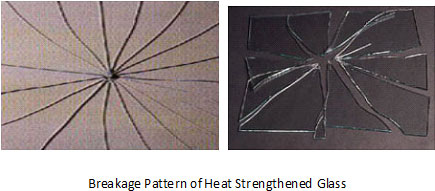Heat Strengthened Glass
Overview of Heat Strengthened Glass:
Heat strengthened glass is similar to tempered glass except that the cooling is done at a much slower pace. Annealed glass is heated to approximately 650-700 º C, but the cooling process is slower than that for tempered glass. Heat strengthened glass is about twice as strong as annealed glass of the same size and thickness. Heat strengthened glass is a semi tempered glass which retains the normal properties of ordinary float glass. Heat Strengthened glass has been strengthened thermally by inducing a surface compression of 6000 to 9000 psi as compared to a range of 11000 to 20000 psi in case of fully tempered glass. Heat strengthening adds strength to the glass while limiting the change in its breakage characteristics. The cooling process places the surfaces of the glass in a state of high compression and the central core in a state of compensating tension.

Heat Strengthening Process:
HS glass – which heats the glass to a uniform temperature of approximately 650º C to 700 º C in an electrically heated horizontal furnace. Ceramic rolls convey the glass through these furnaces at speeds regulated to ensure temperature uniformity and minimal optical distortions. The heat strengthened process parallels the traditional process of glass tempering, except that the cooling cycle is less rapid. However, the heating temperature remains the same for both processes. The residual stress on the edge and the glass surface differ in both cases with tempered glass having a higher level of stress. Due to the relatively low rate of cooling during the strengthening process, heat strengthened glass develops less stress as compared to fully tempered glass. The process increases the mechanical and thermal strength of heat strengthened glass, making it twice as tough as annealed glass.
Characteristics of Heat Strengthened Glass:
Heat-strengthened glass provides the necessary resistance to thermal stress associated with high performance glazing materials such as tinted glass, reflective glass and Low-E glass. It also provides the necessary resistance to heat build up when using spandrels glass.
When producing Heat strengthened laminated glass as compared to Tempered Laminated glass, Heat-strengthened glass allows the internal layer of laminated glass to adhere more evenly because of a flatter finish surface.
Heat-strengthened glass with its flatter surface also results in the facade having less optical distortions.
With the exception of strength and breakage characteristic, heat-strengthened glass retains the normal properties of annealed glass including chemical resistance, hardness, expansion and deflection.
This glass is difficult to break compared to ordinary annealed glass, but unlike toughened safety glass it breaks typically edge to edge and fragments.

Properties of HS Glass:
| Properties | Heat-Strengthened Glass |
| Thermal Shock Resistance | Up to 130°C |
| Mechanical Strength | Two times stronger than annealed glass |
| Fragmentation | Knife Edges |
| Tensile Strength | 40-55 MPa |
| Bending Strength | 40 N/mm2 |
| Design Stress for Architectural Purpose | 17 MPa |
Benefits of heat-strengthened glass:
Heat-strengthened glass differs from tempered glass in surface compression; its mechanical strength is about 1.6-2 times that of annealed glass.
Heat-strengthened glass has outstanding thermal stability, its flatness and light transmission is close to that of annealed glass and much better than that of tempered glass.
HS Glass is 3 times more resistant to thermal stress in comparison to normal annealed glass.
It can withstand temperature difference of 100°C (in range of 50°C to 150°C) compared to ordinary annealed glass which can withstand up to 40°C.
Heat strengthened glass is that it is far less susceptible to spontaneous breakage.
Applications of HS Glass:
Heat-strengthened glass continues to gain popularity and is often the choice of the design professionals for vertical vision spandrel areas and for laminated sloped glazing. Heat-strengthened glass is valued for its mechanical strength which is twice of normal annealed though half of fully tempered glass.
Heat strengthened glass has a comparatively flatter finish than fully tempered glass. It therefore has lesser optical distortions and so can be used in places where high optical quality is required.
It can be used for general glazing where additional strength or resistance to mechanical/thermal loads caused by certain tinted or coated glass. The glass can also be used in high wind load areas, but cannot be used in any safety glazing applications.
Heat-strengthened glass is widely used in laminated glass for additional strength, such as in overhead and sloped glazing.
